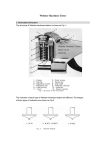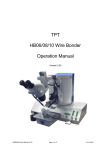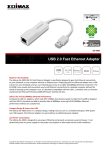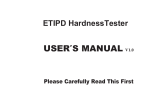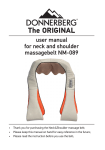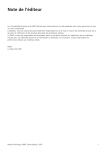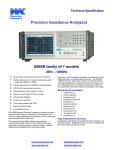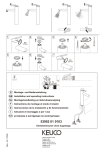Download Indentation HardnessTester acc. to Buchholz Model 263 Technical
Transcript
Indentation HardnessTester acc. to Buchholz Model 263 Test Apparatus with Measuring Microscope testing equipment for quality management Technical Description and Operating Instructions EN ISO 2815 Testing Principle Test and Evaluation In the Buchholz indentation test a test body of specified geometry acts for a prescribed time on the specimen using a defined test load. After a specified recovery time the length l of the resulting indentation is measured using the microscope. Based on the indentation length l in mm, it is possible to calculate: The Buchholz indentation test is conducted in compliance with EN ISO 2815, as follows: • Buchholz indentation resistence = 100/l • indentation depth (µm, approx.) = 8 x l² (1) (2) Both results are rounded to the nearest integers. Application Range The Buchholz indentation test is applicable whenever the following marginal conditions are fulfilled: • The coating to be tested must be even and smooth with a clean surface and applied to a level substrate which will resist the test force. • There must be an adequate coating thickness (i.e. to exceed the indentation depth acc. to (1) above by at least 10 µm). • For comparison testing the specimens should have the same coating thickness; and the conditioning and testing of the specimens should be conducted under identical ambient conditions. Since the indentation test causes only insignificant damage to the coating, testing is also possible on finished products. Design • One of the templates provided with the instrument is affixed to the specimen in such a way that i) the Buchholz impression in the circular cut-out appears in the appropriate position on the specimen, and ii) the measuring microscope, to be oriented at right angles to the impression, can be set up in a stable position. • Align the specimen using the spirit level. • Position the instrument in such a way that the points correspond with the centres of the small circles on the template. • Lower the instrument slowly, setting the indentor gently and without impact onto the specimen. • After 30 ± 1 s, the instrument is lifted vertically from the specimen. • Position the microscope above the indentation on the specimen in such way that the integrated lamp, which is switched on with the black button, illuminates the indentation from the side. • First focus the reticle by rotating the ocular of the microscope, then raise/lower the tubus to adjust the surface of the specimen. • Move the microscope until the cross-lines of the template correspond with those of the reticle in the ocular. • (35 ± 5) s after lifting the instrument measure the length of impression. • Calculate the indentation depth (2) on the basis of the indentation length l in mm and determine whether the method is applicable in this case. • Calculate the Buchholz indentation resistence with (1) based on the indentation length l. The Indentation Hardness Tester, Model 263, consists of a metal block in which two pointed feet and the indentor are imbedded. The indentor of hardended steel comprises a wheel of which the blade-type edge has been ground to 120°. The testing load is set to (500 ± 5) g (equivalent to approx. 5 N). The measuring microscope with a magnification factor of 20 and integrated illumination has a measuring range of 4 mm with 0.1 mm graduation. Technical Data Instrument Dimensions (L x B x H) Net weight 100 x 50 x 40 mm approx. 1 kg Mikroscope Dimensions (L x B x H) Net weightt 125 x 35 x 76 mm approx. 0,18 kg ERICHSEN GmbH & Co. KG Am Iserbach 14 | 58675 Hemer | Germany | Tel. + 49 (0) 23 72 - 96 83-0 | Fax + 49 (0) 23 72 - 64 30 Ordering Information Name of Product 0058.01.31 Indentation Hardness Tester, Model 263, “REFERENCE CLASS” Included in scope of delivery: • Measuring microscope • 9 V-Battery • Spirit level • Selfadhesive Templates (100 pcs.) • Plastic case • Operating Instructions Order No. Subject to technical modifications. Gr. 14 - TBE + BAE 263 - XII/03 | www.erichsen.de | [email protected]


